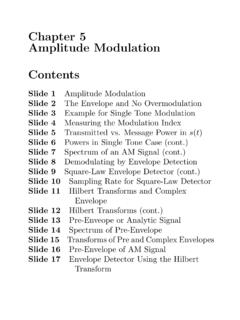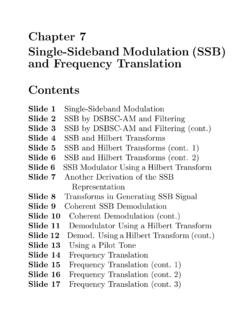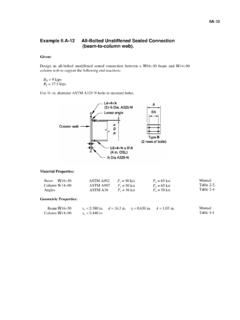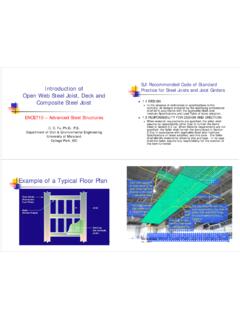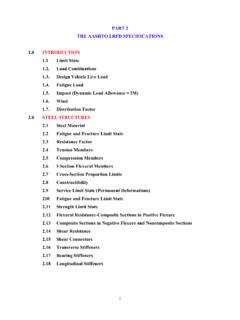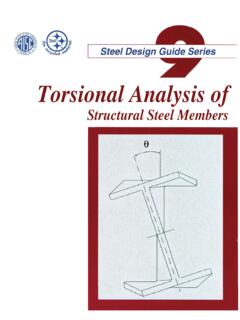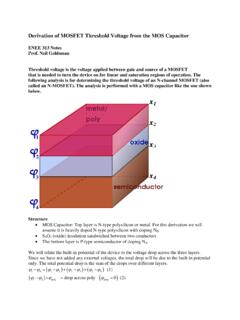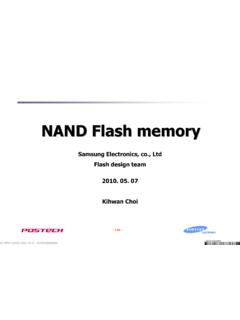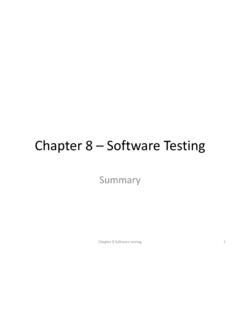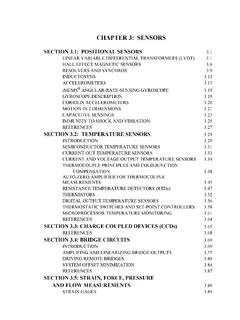Transcription of Chapter 8 Frequency Modulation (FM) Contents
1 Chapter 8 Frequency Modulation (FM)ContentsSlide 1 Frequency Modulation (FM)Slide 2FM Signal Definition (cont.)Slide 3 Discrete-Time FM ModulatorSlide 4 Single Tone FM ModulationSlide 5 Single Tone FM (cont.)Slide 6 Narrow Band FMSlide 7 Bandwidth of an FM SignalSlide 8 Demod. by a Frequency DiscriminatorSlide 9FM Discriminator (cont.)Slide 10 Discriminator Using Pre-EnvelopeSlide 11 Discriminator Using Pre-Envelope (cont.)Slide 12 Discriminator Using Complex EnvelopeSlide 13 Phase-Locked Loop DemodulatorSlide 14 PLL AnalysisSlide 15 PLL Analysis (cont. 1)Slide 16 PLL Analysis (cont. 2)Slide 17 Linearized Model for PLLS lide 18 Proof PLL is a Demod for FMSlide 19 Comments on PLL PerformanceSlide 20FM PLL vs. Costas Loop BandwidthSlide 21 Laboratory Experiments for FMSlide 21 Experiment Making an FMModulatorSlide 22 Experiment FM Modulator (cont. 1)Slide 23 Experiment Spectrum of an FMSignalSlide 24 Experiment FM Spectrum (cont.)
2 1)Slide 25 Experiment FM Spectrum (cont. 1)Slide 26 Experiment FM Spectrum (cont. 3)Slide 26 Experiment Demodulationby a DiscriminatorSlide 27 Experiment Discriminator (cont. 1)Slide 28 Experiment Discriminator (cont. 2)Slide 29 Experiment Demodulation bya PLLS lide 30 Experiment PLL (cont.)8-ii Chapter 8 Frequency Modulation (FM)FM was invented and commercialized afterAM. Its main advantage is that it is moreresistant to additive noise than FrequencyTheinstantaneous frequencyof cos (t) is (t) =ddt (t)(1)Motivational ExampleLet (t) = ct. The instantaneous fre-quency ofs(t) = cos ctisddt ct= Signal for Messagem(t)The instantaneous Frequency of an FM wave withcarrier Frequency cfor a baseband messagem(t)is (t) = c+k m(t)(2)8-1 FM Signal Definition (cont.)wherek is a positive constant called thefrequency oscillator whose Frequency is controlled byits inputm(t) in this manner is called avoltagecontrolled angle of the FM signal, assuming thevalue is 0 att= 0, is (t) = t0 ( )d = ct+ m(t)(3)where m(t) =k t0m( )d (4)is the carrier phase deviation caused bym(t).
3 The FM signal generated bym(t) iss(t) =Accos[ ct+ m(t)](5)8-2 Discrete-Time FM ModulatorA discrete-time approximation to the FM wavecan be obtained by replacing the integral by asum. The approximate phase angle is (nT) =n 1 k=0 (kT)T= cnT+ m(nT) (6)where m(nT) =k Tn 1 k=0m(kT)(7)The total carrier angle can be computedrecursively by the formula (nT) = ((n 1)T)+ cT+k Tm((n 1)T) (8)The resulting FM signal sample iss(nT) =Accos (nT)(9)8-3 Single Tone FM ModulationLetm(t) =Amcos mt. Thens(t) =Accos( ct+k Am msin mt)(10)Themodulationindex is defined as =k Am m=peak Frequency deviationmodulating Frequency (11)Example:fc= 1 kHz,fm= 100 Hz,fs= 80 kHz, = (t)Time in (t)Time in Samples8-4 Single Tone FM (cont.)It can be shown thats(t) has the series exansions(t) =Ac n= Jn( ) cos[( c+n m)t] (12)whereJn( ) is then-th order Bessel function ofthe first kind. These functions can be computedby the seriesJn(x) = m=0( 1)m(12x)n+2mm!
4 (n+m)!(13)Clearly, the spectrum of the FM signal is muchmore complex than that of the AM signal. There are components at the infinite set offrequencies{ c+n m;n= , , } The sinusoidal component at the carrierfrequency has amplitudeJ0( ) and canactually become zero for some .8-5 Narrow Band FM ModulationThe case where| m(t)| 1 for alltis callednarrow bandFM. Using the approximationscosx 1 and sinx xfor|x| 1, the FM signalcan be approximated as:s(t) =Accos[ ct+ m(t)]=Accos ctcos m(t) Acsin ctsin m(t) Accos ct Ac m(t) sin ct(14)or in complex notations(t) Ac e{ej ct[1 +j m(t)]}(15)This is similar to the AM signal except that thediscrete carrier componentAccos ctis 90 out ofphase with the sinusoidAcsin ctmultiplying thephase angle m(t). The spectrum of narrow bandFM is similar to that of The Bandwidth of an FM SignalThe following formula, known asCarson s ruleisoften used as an estimate of the FM signalbandwidth.
5 BT= 2( f+fm) Hz(16)where fis the peak Frequency deviationandfmis the maximum baseband messagefrequency FM signals use a peak frequencydeviation of f= 75 kHz and a maximumbaseband message Frequency offm= 15 s rule estimates the FM signal bandwidthasBT= 2(75 + 15) = 180 kHz which is six timesthe 30 kHz bandwidth that would be required forAM FM Demodulation by a FrequencyDiscriminatorA Frequency discriminator is a device thatconverts a received FM signal into a voltage thatis proportional to the instantaneous Frequency ofits input without using a local oscillator and,consequently, in a noncoherent Elementary DiscriminatorBandpassFilterf0=fc EnvelopeDetector---s(t)m0(t)fcff0jG(f)j8 -8 Elementary FM Discriminator(cont.) When the instantaneous Frequency changesslowly relative to the time-constants of thefilter, aquasi-staticanalysis can be used. In quasi-static operation the filter output hasthe same instantaneous Frequency as theinput but with an envelope that variesaccording to the amplitude response of thefilter at the instantaneous Frequency .
6 The amplitude variations are then detectedwith an envelope detector like the ones usedfor AM An FM Discriminator Using thePre-EnvelopeWhen m(t) is small and band-limited so thatcos m(t) and sin m(t) are essentiallyband-limited signals with cutoff frequencies lessthan c, the pre-envelope of the FM signal iss+(t) =s(t) +j s(t) =Acej( ct+ m(t))(17)The angle of the pre-envelope is (t) = arctan[ s(t)/s(t)] = ct+ m(t) (18)The derivative of the phase isddt (t) =s(t)ddt s(t) s(t)ddts(t)s2(t) + s2(t)= c+k m(t)(19)which is exactly the instantaneous can be approximated in discrete-time byusing FIR filters to form the derivatives andHilbert transform. Notice that the denominator isthe squared envelope of the FM Discriminator Using the Pre-Envelope(cont.)This formula can also be derived by observingddts(t) =ddtAccos[ ct+ m(t)]= Ac[ c+k m(t)] sin[ ct+ m(t)]ddt s(t) =ddtAcsin[ ct+ m(t)]=Ac[ c+k m(t)] cos[ ct+ m(t)]sos(t)ddt s(t) s(t)ddts(t) =A2c[ c+k m(t)] {cos2[ ct+ m(t)] + sin2[ ct+ m(t)]}=A2c[ c+k m(t)](20)The bandwidth of an FM discriminator must beat least as great as that of the received FM signalwhich is usually much greater than that of thebaseband message.
7 This limits the degree of noisereduction that can be achieved by preceding thediscriminator by a bandpass receive A Discriminator Using the Complex EnvelopeThe complex envelope is s(t) =s+(t)e j ct=sI(t) +j sQ(t) =Acej m(t)(21)The angle of the complex envelope is (t) = arctan[sQ(t)/sI(t)] = m(t)(22)The derivative of the phase isddt (t) =sI(t)ddtsQ(t) sQ(t)ddtsI(t)s2I(t) +s2Q(t)=k m(t)(23)z Kz K 2K+1 Tap Hilbert Transform e j cnTs(n)s(n K) s(n K)z Lz L 2L+ 1 Tap Differentiator2L+ 1 Tap Differentiatorz Lz L sI(n K)sQ(n K) + sI(n K L)sQ(n K L) sQ(n K L) sI(n K L) + | s(n K L)| 2md(n)Discrete-Time Discriminator Realization8-12 Using a Phase-Locked Loop for FMDemodulationA device called aphase-locked loop(PLL) can beused to demodulate an FM signal with betterperformance in a noisy environment than afrequency discriminator.
8 The block diagram of adiscrete-time version of a PLL is shown in thefigure below. ------?--- ?666 jsign! y(nT)kvT!cTz 1e j( ) (nT)++PhaseDetectorVoltageControlledOsci llator(VCO)e j (nT)=e j(!cnT+ 1)LoopFilterH(z) ^s(nT)atan2(y;x) (nT) 1 z 1s(nT)=Accos(!cnT+ m) m 18-13 PLL AnalysisThe PLL input shown in the figure is the noislessFM signals(nT) =Accos[ cnT+ m(nT)](24)This input is passed through a Hilbert transformfilter to form the pre-envelopes+(nT) =s(nT) +j s(nT) =Acej[ cnT+ m(nT)](25)The pre-envelope is multiplied by the output ofthe voltage controlled oscillator (VCO) input to thez 1block is the phase of theVCO one sample into the future which is ((n+ 1)T) = (nT) + cT+kvTy(nT) (26)Starting atn= 0 and iterating the equation, itfollows that (nT) = cnT+ 1(nT)(27)8-14 PLL Analysis (cont. 1)where 1(nT) = (0) +kvTn 1 k=0y(kT)(28)The VCO output isv(nT) =e j (nT)=e j[ cnT+ 1(nT)](29)The multiplier output isp(nT) =Acej[ m(nT) 1(nT)](30)The phase error can be computed as m(nT) 1(nT) = arctan[ m{p(nT)} e{p(nT)}](31)This is shown in the figure as being computed bythe C library function atan2(y,x) which is a fourquadrant arctangent giving angles between and.
9 The block consisting of the multiplier andarctan function is called aphase PLL Analysis (cont. 2)A less accurate, but computationally simpler,estimate of the phase error when the error issmall is m{p(nT)}= s(nT) cos[ cnT+ 1(nT)] s(nT) sin[ cnT+ 1(nT)] (32)=Acsin[ m(nT) 1(nT)] Ac[ m(nT) 1(nT)] (33)The phase detector output is applied to theloop filter which has the transfer functionH(z) = + 1 z 1= ( + )1 + z 11 z 1(34)The accumulator portion of the loop filter whichhas the output (nT) enables the loop to trackcarrier Frequency offsets with zero error. It will beshown shortly that the outputy(nT) of the loopfilter is an estimate of the transmitted messagem(nT).8-16 Linearized Model for PLLThe PLL is a nonlinear system because of thecharacteristics of the phase detector. If thediscontinuities in the arctangent are ignored, thePLL can be represented by the linearized modelshown in the following figure.
10 --- 6+H(z)kvTz 11 z 1 LoopFilterVCO m(nT)+ 1(nT)y(nT)The transfer function for the linearized PLL isL(z) =Y(z) m(z)=H(z)1+H(z)kvT z 11 z 1=(1 z 1)( + z 1)1 [2 ( + )kvT]z 1+(1 kvT)z 2(35)8-17 Proof that the PLL is an FMDemodulatorAt low frequencies, which corresponds toz 1,L(z) can be approximated byL(z) z 1kvT(36)ThusY(z) m(z)z 1kvT(37)and in the time-domainy(nT) m((n+ 1)T) m(nT)kvT(38)Using the formula on slide 8-3 for mgivesy(nT) k kvm(nT)(39)This last equation demonstrates that the PLL isan FM demodulator under the Comments on PLL Performance The Frequency response of the linearized loophas the characteristics of a band-limiteddifferentiator. The loop parameters must be chosen toprovide a loop bandwidth that passes thedesired baseband message signal but is assmall as possible to suppress out-of-bandnoise. The PLL performs better than a frequencydiscriminator when the FM signal iscorrupted by additive noise.
